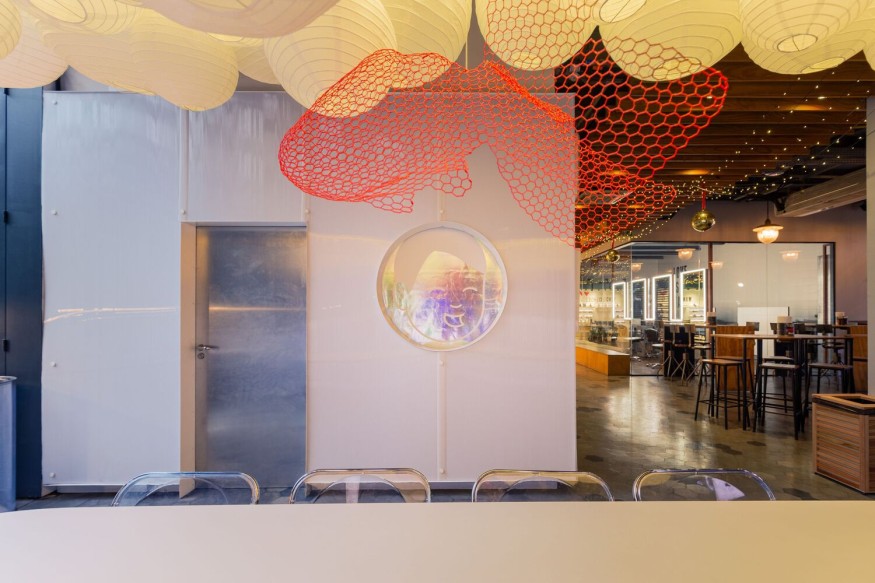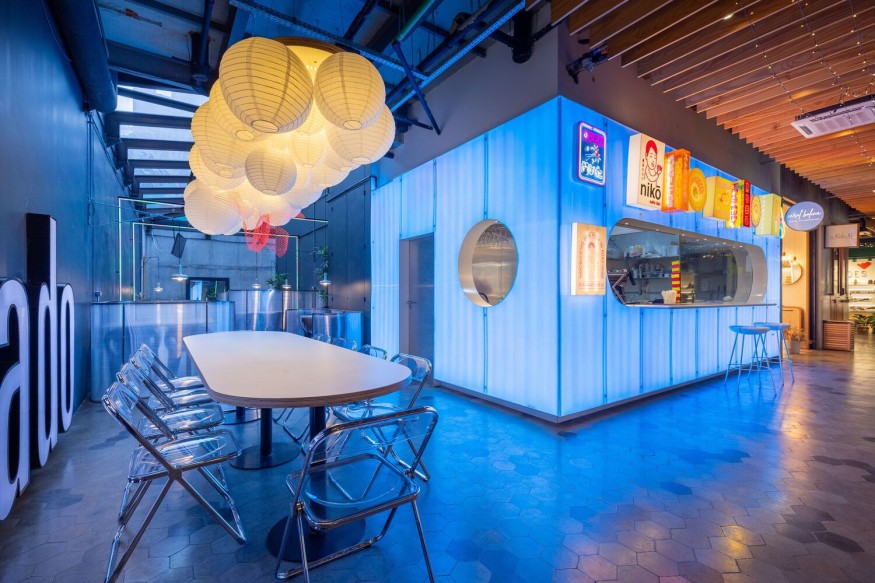Restaurant Niko by URBANODE Unique Architectural Identity Displays a Fusion of Minimalist Japanese Design With Vibrancy of Street Life

Tradition Meets Futurism at Restaurant Niko
In the bustling urban landscape, the architectural narrative of Restaurant Niko by URBANODE Arquitetura stands as a testament to the delicate balance between tradition and the future. The architects embarked on a journey to give materiality to this intriguing contradiction, weaving together elements of street commerce, vibrant lights, and contrasting colors with the solidity of city concrete. The result is a small Japanese restaurant that pays homage to its cultural roots and embraces technological possibilities, projecting a vision of what the future holds for this culinary haven.
Situated within a shopping gallery with two street accesses, Niko beckons patrons through its central facade- an elongated opening resembling a discerning eye that faces one of the entrances. This aperture unveils the compact yet carefully designed space: on the left, the client service area, and on the right, shielded by filmed glass, the bustling kitchen. The smaller side facade houses the discreet employee entrance and another circular opening that harmonizes with the main one, creating a visual dialogue that encapsulates the essence of Niko's architectural philosophy.
Also Read : Noah House by Cadaval Estudio Displays Modern Architectural Ode to Nature's Beauty in Valle De Bravo

The architects aimed to imbue the space with a quality minimalist design reminiscent of Japanese contemporary aesthetics while infusing the vivacity of the streets. To achieve this, polycarbonate, a versatile material, was chosen for the entire facade. Suspended from the ground by custom-designed metallic elements, the polycarbonate sheets create a visually arresting interplay between the structure's solidity and the material's transparency. LEDs concealed behind the polycarbonate panels, controlled by a mobile app, infuse the space with dynamic lighting, reinforcing the technological aspect of Niko's design.
In pursuit of an "over" aesthetic reminiscent of vibrant street life, the architects incorporated small luminous boxes along the elongated opening. These boxes, deliberately misaligned with the polycarbonate module markings, introduce an element of clutter, challenging the conventional notions of minimalist design. The careful juxtaposition of these luminous elements against the clean lines of the facade creates a unique visual experience, enticing passersby to explore the fusion of tradition and modernity within.

Crafting Niko's Architectural Identity through Material Innovation
Delving into the intricacies of materiality, the architects elucidate the workings of the facade. A drywall structure forms the entire "L" of the closure, with a distinctive choice in its composition. Unlike conventional drywall, the external face consists of MDF instead of plaster, chosen for its enhanced support capabilities for the suspended polycarbonate sheets. This thoughtful selection ensures durability and contributes to the overall visual appeal. The internal facade, facing the client area, is crafted with plaster, mirroring the elegance of traditional tile cladding while facilitating the passage of electricity for functional purposes.
Metal tubes with lids secure the polycarbonate sheets, creating a seamless and visually striking facade. Metal sheets cover all openings, presenting a unified, high-standard finish that exudes sophistication. The installation of the light boxes mimics the structure of a TV panel, integrating seamlessly into the overall design. Every element, from the suspended polycarbonate to the custom-designed metallic elements, was meticulously conceived and executed exclusively for the Niko project, contributing to its unique identity in the architectural landscape.
In conclusion, Restaurant Niko, conceived by URBANODE Arquitetura, stands as an architectural marvel that transcends the boundaries of tradition and embraces the future. The fusion of minimalist Japanese design with the vibrancy of street life creates a sensory experience that captivates patrons and passersby alike. Through careful material selection, innovative design choices, and a keen understanding of the interplay between tradition and modernity, Niko exemplifies the power of architecture to tell a compelling story that resonates with the dynamic spirit of a small Japanese restaurant navigating the crossroads of time.
From Digital Models to 3D-Printed Homes: Jaspreet Kaur Lall Explains How the Innovation Changes the Construction Industry

Future Belongs to Green Construction: Sampath Kumar Paspunoori Explains One of the Key Trends in the Construction Industry

Kamala Harris' Campaign Ad Uses Iconic Visuals from Carrie Mae Weems to Connect with Voters

Historic Ancient Roman Ruins in Baalbek Remain Strong After Israeli Air Strikes; Locals Seek Cultural Protection

4 Ways to Honor Departed Loved Ones in Your Home Design













